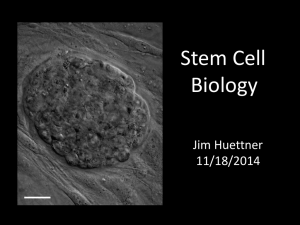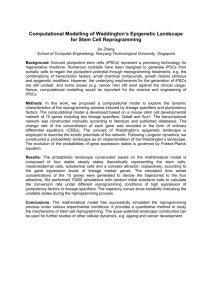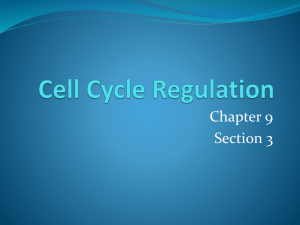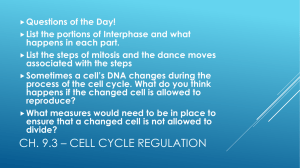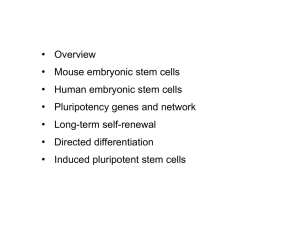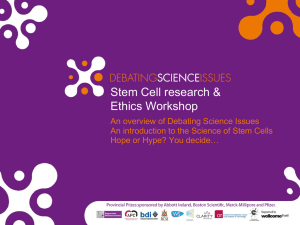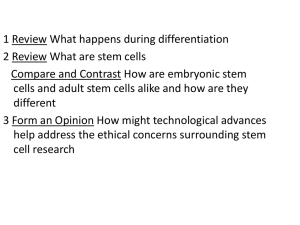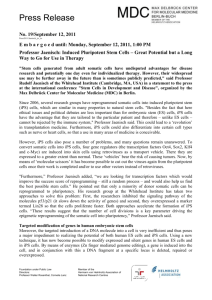Stem Cell Biology - Bio 5068
advertisement
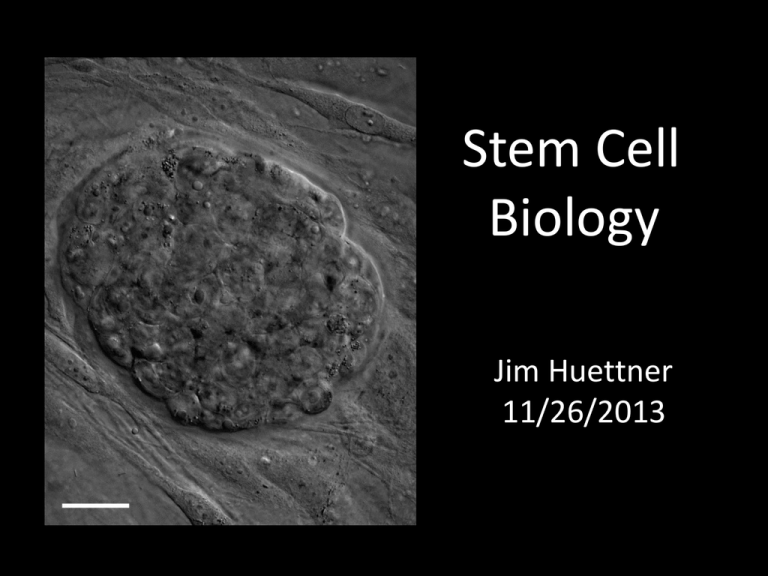
Stem Cell Biology Jim Huettner 11/26/2013 suggested readings • Solter D. (2006) From teratocarcinomas to embryonic stem cells and beyond: a history of embryonic stem cell research. Nat Rev Genet. 7:319-27. • Hanna JH, Saha K, Jaenisch R. Pluripotency and cellular reprogramming: facts, hypotheses, unresolved issues. Cell. 2010 Nov 12;143(4):508-25. • Buganim Y, Faddah DA, Jaenisch R. Mechanisms and models of somatic cell reprogramming. Nat Rev Genet. 2013 Jun;14(6):427-39. • Gafni O. et al., (2013) Derivation of novel human ground state naive pluripotent stem cells. Nature. Oct 30 • Rais Y. (2013) Deterministic direct reprogramming of somatic cells to pluripotency. Nature. 502:65-70. Stem Cells: definition • Self Renewal - undifferentiated cells that can divide repeatedly while maintaining their undifferentiated state. • Pluripotency – ability to differentiate into a variety of different cell types In vitro differentiation: • Cell/tissue replacement therapies • Human model systems of disease and development Donovan and Gearhart, 2001 Types of Stem Cells Embryonic – from the inner cell mass of preimplantation embryos, prior to formation of the 3 germ layers (ectoderm, mesoderm, endoderm) Somatic – undifferentiated cells found in specific locations in “mature” tissues iPS cells – induced pluripotent stem cells generated by reprogramming differentiated cells (or cell nuclei, i.e. therapeutic cloning) Potency • Totipotent – able to generate every cell type including extraembryonic tissues • Pluripotent – able to generate cells from all three embryonic germ layers • Multipotent – able to generate a variety of cells from a particular somatic structure • Unipotent – only generate one cell type Time Line totipotent fertilization zygote morula pluripotent multipotent implantation somatic differentiation blastocyst gastrulation Inner cell mass Epiblast: embryo Hypoblast: yolk sac http://stemcells.nih.gov/info/scireport/pages/chapter1.aspx Early Embryology Human Mouse http://stemcells.nih.gov/info/scireport/pages/appendixa.aspx making a knockout mouse http://en.wikipedia.org/wiki/Knockout_mouse First Isolation of ES cells Mouse: Evans MJ, Kaufman MH. (1981) Establishment in culture of pluripotential cells from mouse embryos. Nature. 292:154-6. Martin GR. (1981) Isolation of a pluripotent cell line from early mouse embryos cultured in medium conditioned by teratocarcinoma stem cells. P.N.A.S. U S A. 78:7634-8. Human: Thomson JA, Itskovitz-Eldor J, Shapiro SS, Waknitz MA, Swiergiel JJ, Marshall VS, Jones JM. (1998) Embryonic stem cell lines derived from human blastocysts. Science. 282:1145-7. Genetic and Developmental Normality (140 cycles): Suda Y, Suzuki M, Ikawa Y, Aizawa S. (1987) Mouse embryonic stem cells exhibit indefinite proliferative potential. J Cell Physiol. 133:197-201. Pluripotency markers • Stage-specific antigens: Anti-SSEA 3 and 4 recognize globo-series gangliosides • Tra1-60 and Tra1-81: keratin sulfate surface antigens • Oct3/4, Sox2, Nanog – transcription factors involved with maintaining pluripotency • Normal karyotype, and pre-X-inactivation? Two types of ES cells? “Naïve” (ICM-like) • • • • • • Blastocyst chimera (+) High cloning efficiency Short doubling time Xa Xa Distal Oct4 enhancer High Nanog, Klf2/4, Rex1 “Primed” (Epi-SC) • • • • • • Blastocyst chimera (-) Low cloning efficiency Long doubling time Xa Xi Proximal Oct4 enhancer Low Nanog, Klf2/4, Rex1 Both types can self renew and give rise to cells from all 3 germ layers in teratomas or following in vitro differentiation maintenance of pluripotency - 1 • Initial work done on mouse embryonic fibroblast (MEF) feeder cells in medium supplemented with animal serum • One factor produced by feeder cells that helps maintain mouse ES cells in their undifferentiated state is leukemia inhibitory factor (LIF) which activates the Stat3 pathway. • Good Manufacturing Process (GMP) – guidelines for isolation and propagation of cells that would be used for replacement therapy. Ideally they would be xeno-free. • The push for xeno-free conditions, combined with work to optimize reprogramming, has driven screening of factors that can enable serum-free maintenance of pluripotency maintenance of pluripotency - 2 “naïve” • • • • Positive Regulators LIF - Stat3 BMP4 - Smad1/5 Wnt (GSK-3 inhibitors) IGF • • • • • “primed” TGFb/activin – Smad2/3 FGF2 ERK1/2 Wnt (GSK-3 inhibitors) IGF Negative Regulators • TGFb/activin-Smad2/3 • FGF2 • ERK1/2 • BMP4 – Smad1/5 maintenance of pluripotency - 3 “Current Standard” Conditions Mouse (2008) • LIF - Stat3 • GSK-3 inhibitors (Wnt) • ERK1/2 inhibitors (2i/LIF) For serum free growth also need: Insulin, transferrin, progesterone, putrescine, selenium Human (2013) • • • • • • • • • LIF – Stat3 GSK-3 inhibitors (Wnt) ERK1/2 inhibitors p38 inhibitor JNK inhibitor FGF2 TGF-b1 ROCK inhibitor PKC inhibitor In vitro differentiation • Different culture conditions alter the fate of ES cells in vitro • Protocols exist for all three germ layers • Many, but not all, protocols involve aggregation of ES cells in “embryoid bodies” • Most protocols do not yield a single type of cell • Selection steps can help to remove undesired cell types • Need to ask: How far? & How faithful? ES cells • pluripotent • functionally immortal • genetically & developmentally normal neurons • • • • postmitotic polarized excitable heterogeneous Serum Free Medium 4d 4d 4d SFD 6d ESC + RA Kim et al., Developmental Biology 328:456-471, 2009 SF+RA Vimentin b-tubulin Developmental Biology 328:456-471, 2009 b-tubulin nestin Hoechst GAP43 MAP2 Hoechst GABA b-tubulin Hoechst voltage-gated Na+ and K+ currents Developmental Biology 168:342-357, 1995 Journal of Neuroscience 16:1056-65, 1996 Hierarchical clustering by frequency of Gene Ontology terms Developmental Biology 328:456-471, 2009 Attempts to define “Stemness” • Early microarray profiles showed surprising lack of agreement (limitations in microarray technology or platform/lab/primary cell or cell line differences) (Science 302:393, 2003) • Relatively weak overlap between mouse and human ES cells (~25%) compared to >90% typical for differentiated tissues. (Stem Cell Reviews 1:111-118, 2005) but this may reflect confusion between naïve and primed ES cells Reprogramming • SCNT – somatic cell nuclear transfer (reproductive and therapeutic cloning) – deterministic and fairly rapid • iPS – induced pluripotent stem cells – slow and stochastic (until recently) • Transdifferentiation – conversion of one terminally differentiated cell type into another without dedifferentiation to an immature phenotype. Must rule out cell fusion or other explanations. Reprogramming: somatic cell nuclear transfer http://www.biotechnologyonline.gov.au/images/contentpages/scnt.gif Reprogramming Firsts: SCNT Frog: Gurdon JB. (1962) Adult frogs derived from the nuclei of single somatic cells. Dev Biol. 4:256-73. Sheep: Campbell KH, McWhir J, Ritchie WA, Wilmut I. (1996) Sheep cloned by nuclear transfer from a cultured cell line. Nature. 380:64-6. Human: (2004) – Claim of human SCNT that proved to be unfounded! Tachibana M, et al. (2013) Human embryonic stem cells derived by somatic cell nuclear transfer. Cell. 153:1228-38. Reprogramming Firsts: iPS cells Mouse: Takahashi K, Yamanaka S. (2006) Induction of pluripotent stem cells from mouse embryonic and adult fibroblast cultures by defined factors. Cell. 126:663-76 Human: Takahashi K, Tanabe K, Ohnuki M, Narita M, Ichisaka T, Tomoda K, Yamanaka S. (2007) Induction of pluripotent stem cells from adult human fibroblasts by defined factors. Cell. 131:861-72. Yu J, Vodyanik MA, Smuga-Otto K, Antosiewicz-Bourget J, Frane JL, Tian S, Nie J, Jonsdottir GA, Ruotti V, Stewart R, Slukvin II, Thomson JA. (2007) Induced pluripotent stem cell lines derived from human somatic cells. Science. 318:1917-20. Generating iPS cells • Express transcription factors: Oct3/4, Sox2, Klf4 and c-Myc OR Oct3/4, Sox2, Nanog and Lin28 • Initial de-differentiation and proliferation (day 1-3, enhanced by Myc); histone modification and chromatin reorganization • 2nd wave of gene expression - stem cell and development related genes (day 9-12); DNA demethylation and X reactivation Graf T. Cell Stem Cell 9:504-516, 2011 Nature Reviews Genetics 14:427-439, 2013 Removing the bottle neck? • Rais et al., Nature 502:65-70, 2013 implicate Mbd3, a component in the NuRD complex that mediates gene repression via histone deacetylation and chromatin remodeling. • Argue that the reprogramming factors recruit both repressive (Mbd3/NuRD) and de-repressive (Wdr5 and Utx) complexes, and reprogramming only occurs when the Mbd3/NuRd repression loses. • Achieve nearly 100% reprogramming within 7 days in cells with Mbd3 reduced or eliminated. Transdifferentiation • Conversion from one differentiated cell type to another without evident de-differentiation and re-differentiation • Must not be confused by cell fusion or selection for rare pluripotent cells in the source material. • Induced by expression of transcription factors and microRNAs Graf T. Cell Stem Cell 9:504-516, 2011 Fibroblasts to neurons • Wernig and colleagues screened 19 transcription factors via lentiviral expression • Found 5 were most critical Asc1, Brn2, Olig2, Zic1 and Myt1l, and 3 were sufficient • 20% conversion within 2 weeks • For human fibroblast conversion also require NeuroD1 and it is less efficient (2-4%) and slower (5-6 weeks for functional synapses) Yang et al., Cell Stem Cell 9:517-525, 2011 Conversion process • Asc1 bHLH transcription factor binds to many of the same genomic loci when expressed in fibroblasts, myoblasts or neural progenitors. • These sites are marked by specific histone modifications (H3K4me1, H3K27acetyl, H3K9me3) • these sites are not accessible in keratinocytes or osteoblasts, which resist transdifferentiation into neurons. • Brn2 Pou-Homeodomain transcription factor is recruited by Asc1 to a subset of locations Goals of Reprogramming: • Models of human disease • Isogenic cells for replacement therapy Aldhous, 2001 Proof of Concept Hanna et al., Science 318:1920-1923, 2007
